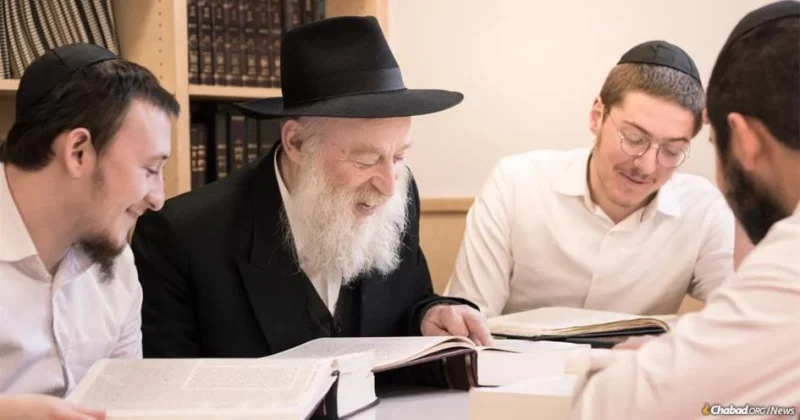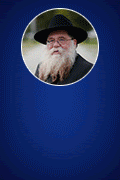
Rabbi Yosef Yitzchok Kalmenson, 70, New England’s Softest-Spoken Sage
by Menachem Posner – chabad.org
Home to Yale University, New Haven, Conn., boasts many towering intellectuals and academics. And for nearly five decades, it was graced with the presence of a pre-eminent Talmudic scholar, whose mental prowess was overshadowed by his humility and whose Talmudic acuity was second only to his unwavering faith, piety and dedication.
Rabbi Yosef Yitzchak Kalmenson, who passed away suddenly on Rosh Hashanah morning at the age of 70, led the Chabad community there for the entirety of his adult life and leaves behind a stellar legacy of scholarship, kindness, and refinement. His parents, Rabbi Yekutiel Dov Ber and Batsheva, were survivors of Stalin’s repression of Jewish life in the Soviet Union, who had rebuilt their lives in Brunoy, a quiet suburb of Paris. There, Yekutiel Dov Ber served as a teacher and fundraiser for the Chabad yeshiva that had been founded, and the couple raised their growing family.
Batsheva, a woman with an extraordinary sense of spiritual sensitivity, told an acquaintance that she was praying that she be blessed with twin boys, so she could name one for her father and one for the Previous Rebbe, who had passed away five years earlier. She also prayed that the boys should grow up to be great Torah scholars. She soon fell pregnant. And on the second day of Adar, 1955, both prayers were answered. She gave birth to twin sons, each of whom would grow up to lead a yeshiva: Rabbi Yosef Yitzchak Kalmenson in New Haven, and his older brother Rabbi Yechiel Menachem Mendel Kalmenson in Brunoy.
As children, the Kalmenson twins stood out for the studiousness, diligence, curiosity and creativity that they invested in their Torah studies. As far away as New York and Israel, there was talk in Chabad circles of two boys, still wearing peaked caps and shorts, who studied Torah together at all hours of day and night.

Under the tutelage of renowned rosh yeshiva, Rabbi Yosef Goldberg, they grew into budding Talmudists, and guided by their spiritual mentor, Rabbi Nissan Nemenow, they developed into aspiring Chassidim.
And already then, they were recording their novel Torah thoughts in notebooks, a foreshadowing of what was yet to come.
Pursuit of Truth
At the age of 15, Yosef Yitzchak traveled to New York, where he met the Rebbe—Rabbi Menachem M. Schneerson, of righteous memory—for the first time.
By 1977, he was 23 years old and studying in Brooklyn, and it was then that he was called to New Haven to lead a yeshiva the Rebbe had established a year before.
Although he was barely older than his students, in his unassuming way, he earned their respect and reverence. “He had an uncanny way of seeing the good in all of his students,” recalled former student, Rabbi Moshe Levin. “Whenever anyone walked into the yeshiva, Rabbi Kalmenson would leap up—literally—with a handshake, a hug, a smile. It didn’t matter if they came every day or once a year. His joy was the same. And when he did, the whole yeshiva stopped. We all knew something special was happening.
“To be in his presence,” concludes Levin, “was to feel seen, valued, and uplifted.”

His style of learning was a reflection of his own personality. He would begin each lecture softly, almost shyly. But by the time he was midway, his voice would grow louder and stronger, animated by his love for Torah.
To him, nothing mattered other than the Torah itself, and he dedicated himself to its explication with selflessness and the highest level of intellectual integrity. He was known to spend an entire lecture positing a certain nuanced approach to the Talmud, only to return to class the next day, after a night of reflection and research, with an entire new approach. This could then repeat itself again and again until he was finally satisfied that his understanding was fully aligned with and reflective of the text and commentaries he was studying.
“To someone on the outside, it might seem strange,” says former student Rabbi Mendel Banon. “Who was this soft-spoken man suddenly raising his voice? But anyone who truly knew him understood: this was Rabbi Kalmenson. Torah was his life, and that fire was him.
Banon says he would sometimes simply stare at the rabbi immersed in his own world, where all the outside noise quieted down and where the only thing that was real were the books open in front of him. “He would hum, he would sing, would stare quietly and once in a while excitedly grab his pen and scribble furiously, expressing a thought or finally answering a seeming contradiction.”
Yet, as advanced as his classes were, he was accessible to all his students. With the student who was not academically ready to study Talmud, he personally learned Mishnah, helping him progress at his own pace.
Humble Giant
In 1978, he married Hindy Shanowitz, and she joined him in serving the community of New Haven, he as the community rabbi and she as a beloved Torah teacher in her own right.
He made sure to be available for his community members, even, or especially the ones whom others overlooked. And his care extended to every detail. One man, who suffered from bed bugs, needed to be taken to a doctor’s appointment. He wrapped the man in a blanket and personally drove him to the appointment.
“Rabbi Kalmenson was a man of superlatives,” attests Rabbi Chanoch Bistritsky, who serves as the yeshiva’s administrator. “By all standards, he was a gaon (genius). His books are classics, used by teachers around the world–both within Chabad and in the broader community–as they prepare their lectures.”
Yet, his most outstanding trait was his genuine humility. In the yeshiva cafeteria, he would stand in line behind his students, waiting his turn to take some food for himself.

As quiet and unassuming as he was, he was beloved as a skilled conversationalist who had an anecdote or Torah thought for every situation. More than once, his son, Rabbi Mendel Kalmenson, recalls, he would sit in rapt silence as someone would repeat one of “his” signature stories back to him, never giving off even the slightest hint that he had heard it before. This was but one of many expressions of his dedication to bestowing dignity and validation on every person he interacted with.
He deeply valued the mitzvah of welcoming guests. The Kalmenson home was right next door to Dovid Deitsch, the yeshiva’s primary patron. Many tzedakah collectors would stop in at the Kalmenson home after receiving a handsome donation from Deitsch. Regardless of the hours, the rabbi would take their coats from them, personally cook food for them, and prepare a bed for them in the guest room.
Sure, the work could be done for others, as a humble soldier in the Rebbe’s army, no task was beneath him and no duty ever grew old for him.
Bistritsky attests that the rabbi had a regular route of Jewish businesses, which he would visit regularly, sharing a Torah teaching and a mitzvah opportunity with each of his “customers.”
“For a period, I was lucky enough to join him on his mivtzoim route on Fridays in West Haven,” recalled former student Moshe New, “mivtzoim” referring to the practice of bringing the Rebbe’s mitzvah campaigns, such as donning tefillin with Jewish men and gifting Shabbat candles to Jewish women, to the streets. “He would drive us in his beaten-up maroon minivan—his driving was best described as erratic. He’d meet with proprietors of all kinds of stores and share a word on that week’s Torah portion, treating the mechanic, the liquor store proprietor, and the man with the little shoe shop with equal respect and warmth.”

There were people he visited weekly and there were those he visited daily. Normally shy and reserved, when it came to helping others perform a mitzvah he was almost transformed into another person, bold, assertive and gregarious.
He would do this not just at home but also when traveling abroad to visit his children. When spending time in Jerusalem, where his daughter, Nechama Dina, leads a Chabad House with her husband, Rabbi Avraham Hendel, he developed a route of “customers,” whom he’d visit daily, always with a smile and a word of encouragement.
To the rest of the world, he was a Talmudist of the highest caliber, but to them, he was the kind rabbi who never tired of helping them put on tefillin and answer their questions.
This humility extended to both community members and family, and anyone else he encountered. “Here was a giant of Torah,” said Rabbi Yosef Katzman, whose daughter is married to the late rabbi’s son. “Yet, he would personally fry me an egg whenever I stayed with them. It was unnecessary, it was humbling, it was disarming—and it was him. A man whose greatness was matched only by his simplicity.”
He abhorred controversy and valued peace. Whenever he sensed that a conversation could possibly be heading toward gossip or the denigration of another, he would either steer it toward a neutral topic or simply leave. When two business partners with whom he put on tefillin had a falling out, he personally facilitated their reconciliation.
‘Class Notes’
For most of the nearly five decades that he led the New Haven yeshiva, his circle of students was relatively small.
As his fame spread, he was offered positions in larger yeshivas, but he was committed and content to remain in New Haven, where he’d been sent by the Rebbe.
From there, his influence extended to yeshivas all over the world, in large part due to the series of 14 scholarly books that he wrote. Under the unassuming title Kovetz Reshimot Shiurim (“Collection of Class Notes”), they became a go-to guide for Talmud teachers all over the world as they prepared their own lectures.
In fact, family and students related that the essays were so good that teachers would often “borrow” his ideas and present them as their own. Several stories are told of renowned Talmud lecturers calling him to apologize for appropriating his teachings without attributing them to him, one during the soul-searching week between Rosh Hashanah and Yom Kippur and another during the wine-laced Purim feast.

The publication of the books was itself a testament to his unique personality. At one point, he entrusted his manuscripts with someone who was going to prepare them for publication. The person then disappeared for seven years. After his son-in-law in Israel finally located the person, the man claimed that he had lost all the files he had worked on over the years. Despite this enormous setback, the rabbi’s only request was: Be sure to pay him for the time he had worked on the manuscript.
In the weeks leading up to his passing, he worked feverishly on preparing the texts for volumes fifteen and sixteen, stressing to the editor his urgent desire to complete them before Rosh Hashanah, as if he knew that his time was coming.
Yet, the lead-up to Rosh Hashanah, the last of his life, was remarkably unremarkable. Even though he was under the weather, he visited his tefillin “customers” and led a group of Jews on a visit to the Ohel, prayed, brought home guests for the Rosh Hashanah meal, and welcomed the new year with joy.
That night, unable to sleep, he studied Torah until daybreak. Then, early Rosh Hashanah morning, his soul ascended on high.
In addition to his wife, he is survived by their children, Chani Altein, Pittsburgh; Nechama Dina Hendel, Jerusalem; Rabbi Mendel Kalmenson, London; Menucha Schochet, Los Angeles; Rabbi Yekusiel Kalmenson, Los Angeles; and Rabbi Moishy Kalmenson, Rockwall, Texas; and many grandchildren. In addition to his twin, his surviving siblings are Chaya Huminer, Doba Vorst, Baila Goldstein, Shterna Spritzer, and Rabbi Yisroel Shimon Kalmenson.













